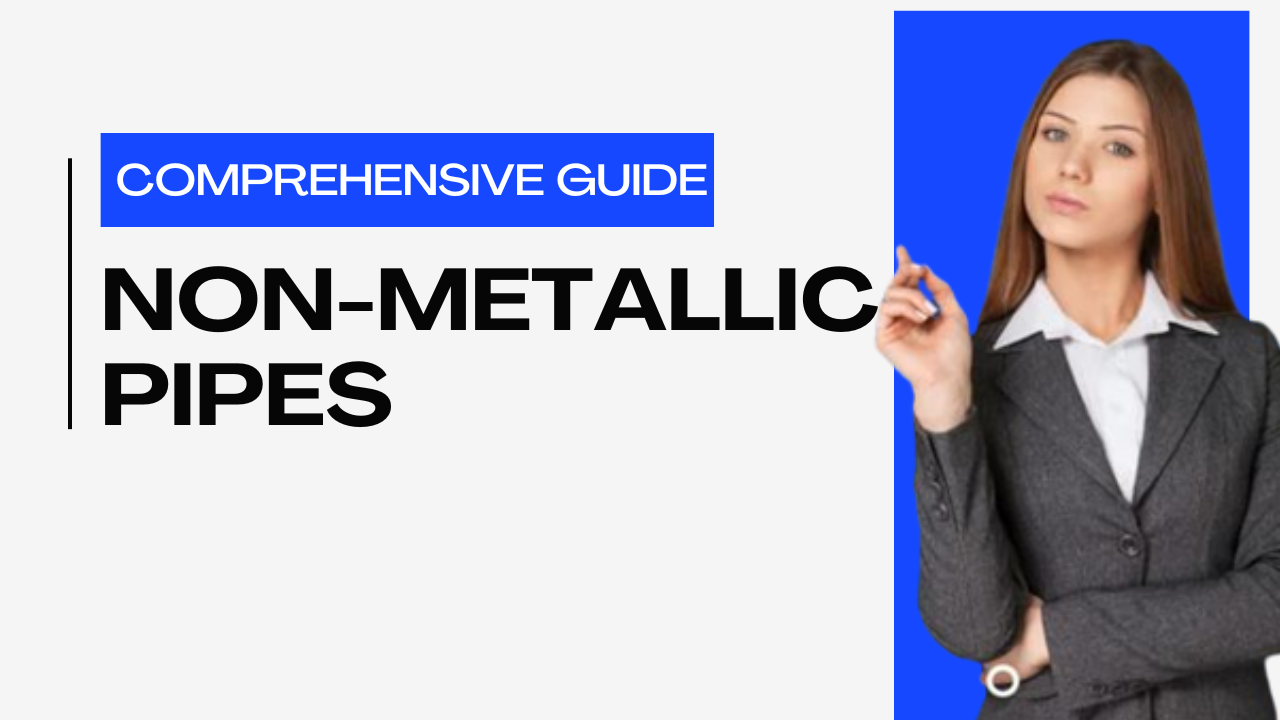Introduction
Piping systems play a crucial role in various industries, from water distribution to chemical processing and infrastructure development. While metallic pipes have been the conventional choice, non-metallic pipes, such as HDPE (high-density polyethylene) pipes, have gained significant attention due to their numerous advantages. In this article, we will delve into the world of non-metallic pipes, exploring their types, advantages, applications, challenges, and the exciting trends that lie ahead.
Table of Contents
Don’t miss the Detailed course on 7 Modules for Piping Codes & Standards
Enrollment Link
Types of Non-Metallic Pipes
1. Polymer-Based Pipes
Polymer-based pipes, such as PVC (polyvinyl chloride), HDPE (high-density polyethylene), and PEX (cross-linked polyethylene), have gained popularity for their versatility and benefits. PVC pipes are known for their corrosion resistance, lightweight nature, and ease of installation. They find applications in plumbing, irrigation, and drainage systems due to their durability and cost-effectiveness.
HDPE pipes are celebrated for their exceptional strength-to-weight ratio, making them ideal for underground applications. Their flexibility and resistance to chemical abrasion position them as a reliable choice in industries like chemical processing, mining, and agricultural irrigation. PEX pipes, renowned for their flexibility and resistance to freeze damage, are often utilized in residential plumbing and radiant heating systems.
2. Composite Pipes
Composite pipes, which include materials like FRP (fiber-reinforced plastic), GRP (glass-reinforced plastic), and GRE (glass-reinforced epoxy), offer a unique blend of strength and durability. These pipes are highly resistant to corrosion, making them suitable for chemical processing plants and offshore oil and gas applications. Their lightweight nature reduces transportation costs and facilitates installation.
FRP pipes combine the mechanical properties of fibers with the chemical resistance of polymers. They are used in industries where high-strength and corrosion-resistant materials are required, such as in desalination plants and wastewater treatment facilities. GRP and GRE pipes find applications in harsh environments, including offshore drilling platforms and industrial plants where corrosive substances are present.
3. Concrete Pipes
Concrete pipes stand out for their exceptional load-bearing capacity and longevity. They are commonly used in sewer systems, culverts, stormwater management, and drainage applications. Concrete pipes can withstand significant external pressures and are resistant to biological and chemical degradation. Their durability makes them a preferred choice in infrastructure projects, where long-term performance is essential.
Similar Articles related to Pipe
| Topic | Weblink | Topic | Weblink |
|---|---|---|---|
| Pipe Insulation Materials | Link | ASME B36.10 | Link |
| Piping Codes & Standards | Link | Non-Metallic Pipes | Link |
| Pressure-Temperature Ratings | Link | Pipe Standards & Specifications | Link |
| Pipes for Different Fluids | Link | Pipe Coatings & Linings | Link |
| Pipe Materials Selection Guidelines | Link | Corrosion & Pipe Protection | Link |
| High-Temperature Pipes | Link | Pipe Dimensions & Sizes | Link |
| Pipe Manufacturing Processes | Link | Types of Pipes in Piping Systems | Link |
| Pipe Thickness Calculations | Link | Pipe Inspection & Testing | Link |
Advantages of Non-Metallic Pipes
3.1. Corrosion Resistance
One of the most significant advantages of non-metallic pipes is their inherent resistance to corrosion. Metallic pipes, over time, are susceptible to rust and degradation when exposed to corrosive substances. Non-metallic pipes, including HDPE pipes, on the other hand, remain unaffected by such factors. This corrosion resistance leads to longer lifespans, reduced maintenance costs, and fewer disruptions in operations.
3.2. Lightweight Construction
The lightweight nature of non-metallic pipes provides several benefits. Transporting and installing non-metallic pipes are simpler and more cost-effective due to their reduced weight. This aspect is particularly advantageous in remote locations and areas with challenging terrains. Additionally, the ease of handling reduces the need for heavy equipment during installation, further lowering costs.
3.3. Chemical Resistance
In industries where chemicals are transported, such as chemical processing and wastewater treatment, the chemical resistance of non-metallic pipes is invaluable. Metallic pipes can corrode and degrade when exposed to aggressive chemicals, leading to leaks and potential environmental hazards. Non-metallic pipes can withstand a wide range of corrosive substances, ensuring the safety of workers, the environment, and the infrastructure itself.
3.4. Thermal Insulation
Non-metallic pipes, including HDPE pipes, often possess superior thermal insulation properties compared to metallic counterparts. This insulation capability is crucial when transporting fluids at different temperatures. Non-metallic pipes help maintain the temperature of the transported materials, whether they are hot or cold, reducing energy loss and promoting operational efficiency.
Don’t miss the Detailed course on 7 Modules for Piping Codes & Standards
Enrollment Link
Applications of Non-Metallic Pipes
4.1. Water Distribution and Plumbing
Non-metallic pipes have revolutionized water distribution and plumbing systems. In municipal water supply networks, PVC and HDPE pipes have become go-to choices due to their corrosion resistance and affordability. In addition to being easy to install, these pipes ensure clean and safe water delivery, preventing contamination and improving public health.
4.2. Oil and Gas Industry
The oil and gas industry has embraced non-metallic pipes, including HDPE pipes, for both offshore and onshore applications. These pipes excel in transporting oil, gas, and corrosive fluids without the risk of corrosion-related leaks. In offshore platforms, where harsh environmental conditions prevail, composite pipes offer durability and reliability, contributing to the safety and efficiency of operations.
4.3. Chemical Processing
Non-metallic pipes play a vital role in chemical processing plants. Their resistance to chemical corrosion ensures the integrity of fluid transport systems, preventing accidents and environmental damage. Industries dealing with acids, alkalis, and aggressive chemicals rely on non-metallic pipes to maintain the quality of their products and the safety of their workforce.
4.4. Infrastructure and Construction
Concrete and composite pipes are essential components of modern infrastructure. Concrete pipes are used in sewer systems, culverts, and stormwater management, providing longevity and robustness. Composite pipes find applications in tunnels, bridges, and drainage systems, contributing to the development of sustainable and resilient urban landscapes.
Challenges and Considerations
5.1. UV Degradation and Environmental Factors
While non-metallic pipes exhibit remarkable resistance to many environmental factors, some materials can degrade when exposed to prolonged UV radiation. To mitigate this, manufacturers are developing UV-stabilized materials and coatings, ensuring the longevity of non-metallic pipes in outdoor installations.
5.2. Temperature and Pressure Limitations
Non-metallic pipes have specific temperature and pressure thresholds based on the material. It’s crucial to select the appropriate material for each application to prevent performance issues or failures. Engineers and project managers need to consider factors such as fluid temperature, pressure, and external conditions when designing systems with non-metallic pipes.
5.3. Joining and Installation Techniques
Joining and installing non-metallic pipes differ from traditional metallic pipes. Some materials require specialized techniques, tools, and skills for proper installation. Incorrect installation can lead to leaks, reduced performance, and increased maintenance requirements. Following manufacturer guidelines and training personnel adequately are crucial steps in ensuring the long-term success of non-metallic piping systems.
Don’t miss the Detailed course on 7 Modules for Piping Codes & Standards
Enrollment Link
Future Trends and Innovations
6.1. Advanced Materials
The future of non-metallic pipes lies in the development of advanced materials. Researchers are exploring nanotechnology and graphene to enhance the properties of existing materials, such as increasing strength and improving thermal and electrical conductivity. These innovations could lead to pipes with superior performance characteristics, opening doors to new applications and industries.
6.2. Smart Piping Systems
The integration of sensors and IoT technology into piping systems is an exciting trend. Smart pipes equipped with sensors can provide real-time data on factors like pressure, temperature, and flow rates. This data enables predictive maintenance, optimizing operations, and preventing downtime by identifying potential issues before they escalate.
6.3. Sustainability and Circular Economy
The push towards sustainability and the circular economy is impacting the pipe manufacturing industry. Researchers and manufacturers are exploring recyclable materials and methods to reduce the environmental impact of pipe production and disposal. Repurposing and reusing non-metallic pipes at the end of their lifecycle could contribute to a more sustainable future.
Conclusion
Non-metallic pipes, including HDPE pipes, have proven their worth in various industries, offering corrosion resistance, lightweight construction, chemical resilience, and thermal insulation. From water distribution to chemical processing and infrastructure development, non-metallic pipes have enabled safer, more efficient, and environmentally conscious operations. As technological advancements continue to shape the landscape, the future holds promising innovations that will further enhance the capabilities and applications of non-metallic piping systems.
FAQs
1. What are non-metallic pipes, and why are they gaining popularity?
Non-metallic pipes are pipes made from materials other than metals, such as polymers, composites, and concrete. They are gaining popularity due to their corrosion resistance, lightweight construction, chemical resilience, and thermal insulation properties. These advantages make them suitable for a wide range of applications, from water distribution to chemical processing and infrastructure development.
2. What are some common types of non-metallic pipes?
Common types of non-metallic pipes include PVC (polyvinyl chloride), HDPE (high-density polyethylene), PEX (cross-linked polyethylene), FRP (fiber-reinforced plastic), GRP (glass-reinforced plastic), GRE (glass-reinforced epoxy), and concrete pipes. Each type has unique properties that make them suitable for specific applications, such as chemical resistance, durability, and load-bearing capacity.
3. How do non-metallic pipes compare to metallic pipes in terms of corrosion resistance?
Non-metallic pipes have a significant advantage in terms of corrosion resistance compared to metallic pipes. Metallic pipes, over time, can corrode and degrade when exposed to corrosive substances. Non-metallic pipes, including materials like HDPE, PVC, and composites, remain unaffected by such factors. This resistance leads to longer lifespans, reduced maintenance costs, and improved operational reliability.
4. What are the challenges and considerations associated with non-metallic pipes?
While non-metallic pipes offer numerous benefits, there are also challenges to consider. UV degradation, temperature and pressure limitations, and specialized joining and installation techniques are some of the key challenges. UV degradation can affect certain non-metallic materials exposed to sunlight for extended periods. Temperature and pressure limitations vary based on the material, and proper installation techniques are essential to prevent leaks and ensure long-term performance.
5. What is the future outlook for non-metallic pipes?
The future of non-metallic pipes looks promising. Researchers are focusing on developing advanced materials through nanotechnology and graphene integration, aiming to enhance properties like strength and conductivity. Smart piping systems, equipped with sensors and IoT technology, are expected to optimize maintenance and prevent issues. Moreover, the industry is increasingly considering sustainability, exploring recyclable materials and circular economy practices to reduce environmental impact.
Recommended courses (Published on EPCLand)
- Basics of Piping Engineering
- Piping Layout Engineering
- Piping Material Engineering
- Piping Stress Analysis
- Complete Course on Piping Engineering
- Material Requisitions
- Piping Material Specifications
- Valve Material Specifications
Don’t miss the published articles on following:
Related Video
Attempt Quiz
Question 1:
What are non-metallic pipes primarily made of?
Explanation: Non-metallic pipes are primarily made of plastic, PVC (polyvinyl chloride), or composite materials that offer corrosion resistance and other advantages.
Question 2:
Which of the following is an advantage of using non-metallic pipes?
Explanation: An advantage of using non-metallic pipes is their resistance to chemicals and rust, making them suitable for transporting corrosive fluids.
Question 3:
Which application is non-metallic pipe commonly used for?
Explanation: Non-metallic pipes are commonly used for industrial cooling water systems due to their resistance to corrosion and the ability to handle different fluid temperatures.
Question 4:
What is a consideration when installing non-metallic pipes?
Explanation: A consideration when installing non-metallic pipes is their compatibility with metal fittings, as proper jointing methods are necessary to ensure leak-free connections.
Question 5:
Which factor makes non-metallic pipes less suitable for high-temperature applications?
Explanation: Non-metallic pipes have a lower melting point compared to metal pipes, making them less suitable for high-temperature applications where the material may degrade or soften.



